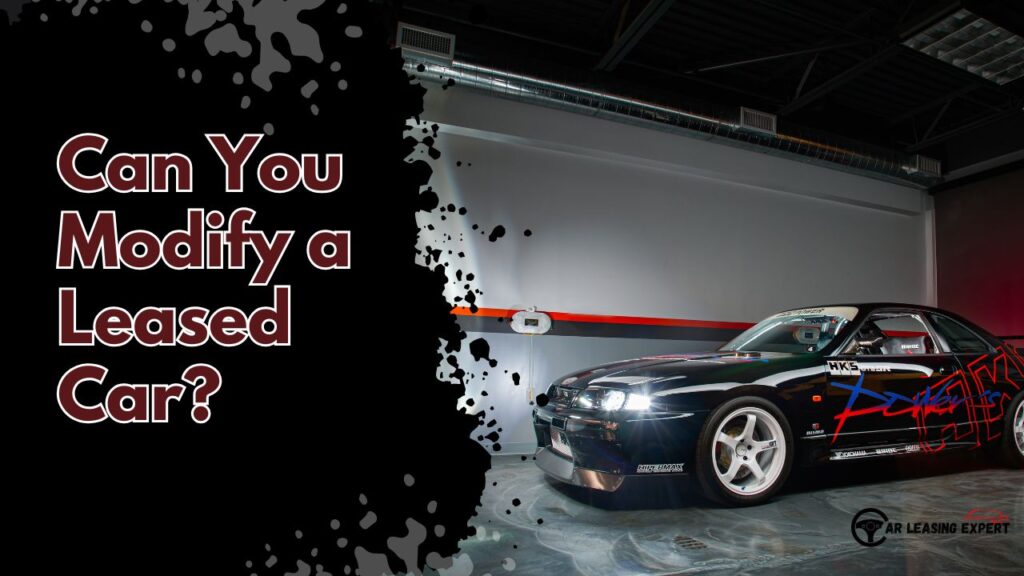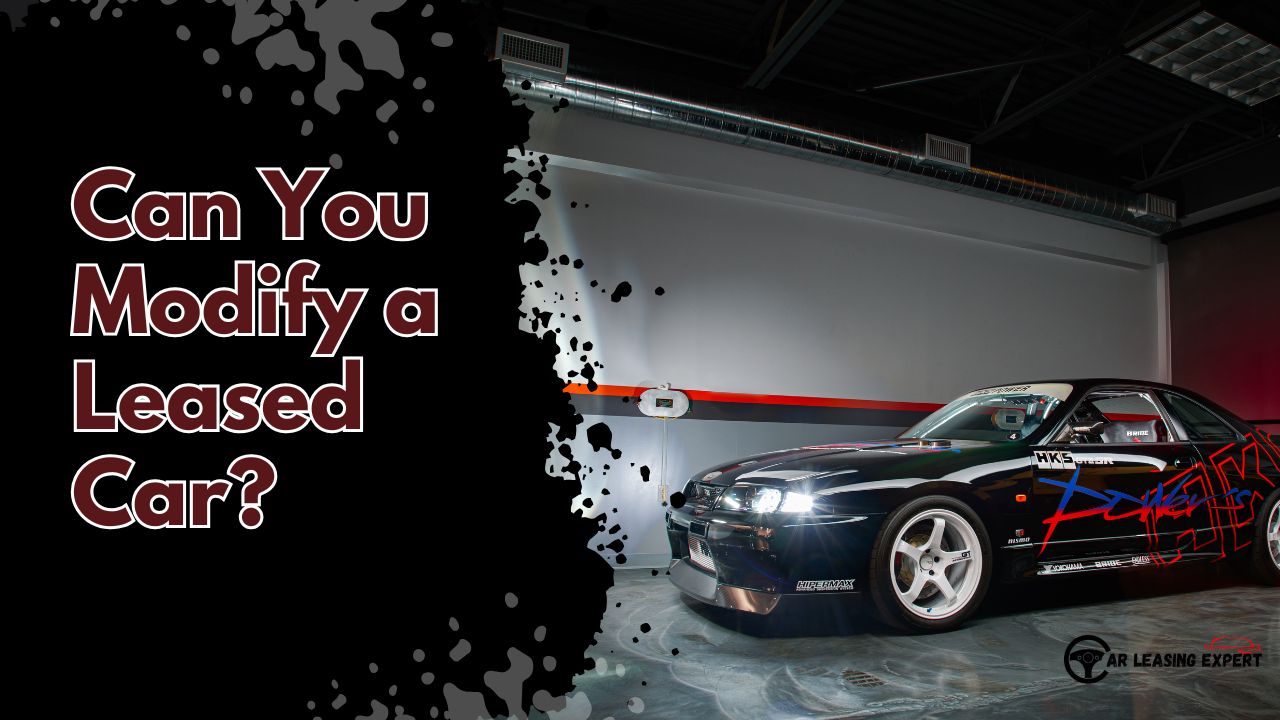Leasing a car is a great option if you enjoy driving a brand-new vehicle while keeping your monthly payments lower. But what if you want to customize it? Since you don’t technically own the car, there are rules about what you can and can’t do. Leasing companies usually expect you to return the vehicle in good condition, so modifications can be tricky.
In this article, we’ll go over the types of modifications you can make to a leased car without breaking your contract.

Can You Modify a Leased Car?
Lease agreements often include terms and conditions regarding vehicle modifications. Most leasing companies prefer that the vehicle remain in its original condition to maintain its resale value. As such, modifications are often restricted or require prior approval from the leasing company.
What Customizations Are Allowed In A Leased Car?
If you want to customize your leased car, it’s important to understand the terms of your lease agreement. You don’t want to make any changes that could violate your contract.
Start by checking with your leasing company to see what modifications, if any, they allow. Generally, non-damaging, temporary, and reversible changes are acceptable.
For example, avoid installing permanent modifications like an aftermarket spoiler. Even though it can technically be removed, installing one requires drilling holes, which could damage the car.
If you want a sportier or more luxurious look, consider upgrading the tires or rims. This is one of the easiest modifications since you can swap back to the original wheels before returning the car at the end of your lease.
You can also enhance your car with aftermarket exhaust or intake systems, as well as upgraded radios or electrical components. Just make sure these additions won’t damage the original parts of the vehicle. Keep all stock components so you can reinstall them before returning the car.
Do and Don’t In A Leased Car
Unlike when you finance your vehicle, you don’t become the owner of a leased vehicle after paying off the balance.
You pay a fixed monthly rate to borrow the vehicle from the rental company for a specific period of time. This means that the lessor will have very restrictive terms and conditions that you must abide by while driving their vehicle.
What is usually included in your contract is a clause stating that the dealer must return the vehicle in the same condition as when you drove it from the dealership. This makes customizing your leased vehicle tricky.
If you insist on modifying your leased vehicle, your best bet is to make non-permanent modifications that can be removed before the end date of the lease.
What Customizations Are Allowed?
If you plan to customize your leased car, make sure you fully understand your lease agreement. You don’t want to make any changes that could violate your contract.
Check with your leasing company to see which modifications, if any, are allowed. Generally, temporary, non-damaging, and easily reversible changes are acceptable.
Permanent modifications, like installing an aftermarket spoiler, should be avoided. Although they can be removed, installing one usually requires drilling holes, which could damage the car.
Upgrading the tires or rims is a simple option if you want a sportier or more luxurious look. Just be sure to keep the original wheels so you can swap them back before returning the vehicle.
Other enhancements, such as aftermarket exhaust systems, intake systems, or upgraded radios and electrical components, can also be made. However, ensure that these modifications won’t damage the original parts, and always keep the stock components so you can reinstall them before the lease ends.
Some minor modifications may be permissible as long as they are reversible. These include:
- Window tints (subject to local laws and lease approval)
- Non-permanent vinyl wraps
- License plate frames and stickers
- Removable seat covers and floor mats
- Plug-and-play performance tuners (easily removable)
Steps to Modify a Leased Car
Review the Lease Agreement – Carefully read your lease contract to understand the rules about modifications. Look for any clauses that specifically allow or prohibit certain changes.
Contact the Leasing Company – Before making any modifications, reach out to your leasing company. Explain the changes you want to make and ask if they are allowed.
Get Approval in Writing – If the leasing company approves your modifications, request written confirmation. This can help protect you from disputes when returning the car.
Choose Reversible Modifications – Stick to changes that can be easily undone. This will ensure the car can be returned to its original condition at the end of your lease.
Professional Installation – Have any modifications done by a professional to prevent damage. Keep all receipts and records of the work in case you need them later.
What Happens If You Modify a Leased Car Without Approval?
Modifying a rental vehicle without the rental company’s approval can have several potential consequences. Here’s what you need to know:
1. Breach of Rental Agreement
Unauthorized modifications are considered a breach of the rental agreement. This can result in penalties and additional fees when you return the vehicle.
2. Additional Fees
The rental company may charge you for the cost of restoring the vehicle to its original condition. This includes labor and parts required to reverse the modifications.
3. Warranty Voiding
Many modifications, especially performance-related ones, can void the vehicle’s warranty. This means you would be responsible for any repairs or maintenance that would otherwise have been covered by the warranty.
4. Financial Responsibility
If the modifications result in any damage or mechanical issues, you could be held financially responsible for the repairs. This can result in significant out-of-pocket expenses.
5. Negative Impact on Credit
Failure to comply with the lease agreement and any associated financial obligations can negatively impact your credit rating. This can affect your ability to lease or finance a vehicle in the future.
6. Termination of Lease
In severe cases, unauthorized modifications can result in early termination of the lease agreement. This can result in early termination fees and immediate return of the vehicle.
Read More: Will My Credit Score Go Down After I Turn In a Leased Car?
What Are Some of the Possible Penalties?
Modifying your leased vehicle without approval from the leasing company can end up costing you a lot.
Some major changes can void the manufacturer’s warranty, meaning you’ll have to pay out of pocket for repairs that would have otherwise been covered.
You could also face extra charges at the end of your lease if the car doesn’t meet the dealer’s return standards.
Before returning the vehicle, the dealer will conduct an end-of-lease inspection, usually 60 to 90 days before your lease expires. If any unapproved modifications are found, you may be required to remove them. In some cases, the dealer can charge expensive fees and penalties for violating the lease agreement.
What if I Plan on Buying It?
Before you sign a lease on a vehicle you already know you want to modify, consider financing it. This may cost you more money in the short term, but it could save you money and hassle down the road if modifications are something you really want to purchase.
If you’ve already signed a lease, you can usually buy the vehicle once the lease term is up. Dealers will typically give you priority to buy the vehicle before putting it back on the market. Your lease should include a purchase price, which is the price the dealer is willing to sell you the vehicle for once the lease is up (don’t forget this).
Related Articles: Is It Better To Leasing a Car VS Buying a Car





